If you thought Mumbai was just a concrete jungle, perish the thought. It also has in its fold some breath-taking architectural marvels widely regarded as a heady mix of Art Deco, Gothic, Victorian, Indo-Saracenic and Contemporary styles. The diverse mix can be traced back to centuries with a spectrum of influences. Some have made it as heritage sites even as the city grows as a global trade hub. Manu Shrivastava takes a long, hard look at these sites that give the city an old world charm.

 David Sasoon Library and University of Mumbai, both neo Gothic architecture
David Sasoon Library and University of Mumbai, both neo Gothic architecture
Mumbai is one of those few cities in the world that offer visitors an assortment of things to do, see and experience. If it’s not the interesting lot of people pacing the city’s streets, it’s the magnificent architecture that attracts tourists, art lovers, photographers and filmmakers, history enthusiasts, etc., from all over the world.
Mumbai is known to have some of the most awe-inspiring architectural marvels among the urban centres in the country. The architecture is a blend of Art Deco, Gothic, Victorian, Indo-Saracenic and Contemporary architectural styles.
The exquisite structures, buildings, landmarks, historical monuments scattered through the city are a reminder of the city’s rich and diverse cultural make-up and are a reflection of the myriad influences that have shaped the city’s architecture through centuries.
Evolution of the city’s architecture
Like any other city, Mumbai too has evolved and metamorphosed over centuries and through various influences to be what it is today. Erstwhile Bombay’s success as a global trading hub had led to rapid expansion and construction activities towards the end of the 19th and beginning of the 20th centuries to meet the demands of new immigrants making a beeline to a flourishing city.
Bombay, for the first time, witnessed planned development and the city matured from a lacklustre, fortified trading port to a modern, cultured city. The first wave of construction in late 19th century witnessed a flurry of Victorian Gothic-styled public buildings such as David Sassoon Library, Bombay High Court and Mumbai University at Fort.
A second expansion in early 20th century initiated Backbay Reclamation that extended into construction of buildings in contemporary Art Deco style and the Marine Drive sea front (the Queen’s Necklace) on Bombay’s western coast.
It’s this unique blend of architectural heritage that lures millions of tourists to Mumbai from across borders and the interest has only increased in the last decade.
The simplicity of art deco
It was the iconic Regal Cinema in Colaba that was one of the first structures to be built in Art Deco style in Mumbai. The theatre built by Framji Sidhwa happens to be India’s first air-conditioned theatre and the first film to be aired here was The Devil’s Brother in 1933.
The cinema was designed by Charles Stevens, interiors were done by Czech artist Karl Schara who brought in extensive mirror work in the building. Around the same time and later, many other similar cinemas opened in Mumbai including Plaza Central, Broadway, New Empire, Eros, Metro, Liberty, etc. Eros Cinema is a typical art deco building designed by architect Sohrabji Bhedwar. The cinema was built in 1935 partially faced with red Agra sandstone and the building painted in cream.
After Regal Cinema came a range of buildings — commercial, residential and cinema houses in Mumbai built in similar architectural style. Art Deco was one of the most fashionable design movements of modern art that manifested into architecture, decorative arts, painting and beyond.
Much later, gorgeous homes soaked in Art Deco style were built for the affluent in the Malabar and Cumbala hills areas. Other pockets in the city including Apollo Bunder, Colaba, Fort, Dadar and Mahim also witnessed construction of commercial buildings and residential structures with similar architectural elements. The sea-facing buildings lining the Gateway of India promenade in Colaba are built in Art Deco architectural style.
 Chhatrapati Shivaji Maharaj Terminus (CSMT) built in Victorian-Gothic style
Chhatrapati Shivaji Maharaj Terminus (CSMT) built in Victorian-Gothic style
Deriving origin from the Exposition Internationale des Arts Decoratifs Industriels et Modernes, held in 1925 in Paris, Art Deco style is characterised by flat roofs, smooth lines, geometric shapes, streamlined forms, curvilinear balconies, modern building materials in vivid colours and bold exterior motifs or stylised ornamentation.
Art Deco defines Mumbai’s skyline
One of the city’s most noticed architectural styles, Art Deco can be seen in many structures and buildings across Mumbai. Other than the cinemas, most buildings along Marine Drive and on the west end of Oval Maidan display this architectural style. There are hundreds of structures imbibing the Art Deco style — Empress Court, Dhanraj Mahal, Keval Magal, Shiv Shakti Bhuvan, Rajjab Mahal, Soona Mahal, Motabhoy Mansion, Taraporewala Aquarium, New India Assurance building — to name a few.
Art Deco in India (especially in Mumbai) evolved into a unique style that was later named as Deco-Saracenic which is a combination of the Islamic and the Hindu architectural styles.
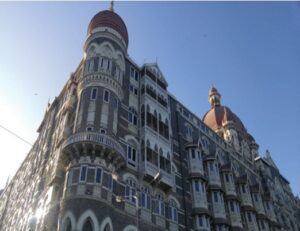 The iconic Taj Mahal Palace Hotel at Colaba, Mumbai
The iconic Taj Mahal Palace Hotel at Colaba, Mumbai
Primary features of the Indo-Saracenic style included construction of domes, arches, spires, stained glasses and minarets – interiors with Victorian influence and exteriors with a more Indian touch.
Today, Oval Maidan and the surrounding buildings — commercial, residential and entertainment — have become the hub of Art Deco enthusiasts from all over. The ground offers a breathtaking view of Art Deco edifices that coalesce the Indian design with Art Deco imagery to create the ‘Indo-Deco’ style — a testimony of the confluence of Indian and European influences.
The simplicity and elegance attributed a timeless appeal to the style that spread all over the world. New York City, Miami, Istanbul, Durban and most major cities adopted Art Deco but with variations of native needs decided mainly by weather and the environment. The design elements reflected the culture of the zone depicted in representational forms. So, Bombay developed its own style…Bombay Deco!
Mumbai’s structures and UNESCO heritagesites
Some of the most iconic structures in Mumbai have been constructed in Gothic Revival, also known as Victorian Gothic or Neo Gothic architecture – an architectural movement that began in the late 1740s in England and expanded soon after.
Gothic architecture had become the most prominent architectural style in the Western world by mid-19th century. It relied heavily on the distinct features of medieval examples that include decorative patterns, finials, lancet windows and hood moulds.
The Victorian Gothic and Art Deco Ensembles of Bombay is a collection of 19th-century Victorian neo-Gothic public buildings and 20th-century Art Deco in Mumbai buildings in Mumbai’s Fort area and was declared a UNESCO World Heritage Site in 2018.
This ensemble is set around the Oval Maidan – with Victorian Gothic buildings on the east and Art Deco buildings of Backbay Reclamation and Marine Drive on the west facing the Arabian Sea. The UNESCO World Heritage Site nomination aims to safeguard a total of 94 buildings.
The distinct style of Gothic structures
Most iconic structures in South Mumbai are built in Victorian Gothic architecture. The 19th century Victorian Gothic buildings that lie to the east of the Oval Maidan including Bombay High Court and several others in the precinct such as the Chhatrapati Shivaji Maharaj Terminus (CSMT) building stand tall displaying this architecture at this best.
The Brihan Municipal Corporation building also known as the BMC building that lies opposite CSMT is also built in Gothic revival style. Two designs were considered for this structure – one of the Gothic designs done by Frederick William Stevens and the other in the Indo-Saracenic design presented by Robert Fellowes Chisholm. Eventually, a blend of Venetian Gothic andcompleted in 1893.
The architecture in the fast growing port city of Bombay in the 18 th and 19 th centuries was a result of the British influence. At first it was the neoclassical style of architecture and later the Victorian Gothic style (also known as Gothic revival) that dominated the city’s architecture.
The Victorian Gothic style is expressive and imbibes several unique elements such as surfaces of lives colours, beautified with carved and narrative elements, consisting of flying buttresses, lancet windows and stained glass, etc.
Just like any other art form, architecture too is influenced by local flavours. Indian architects analysed this in their own way and the result was a blended style with Gothic and contemporary elements that came to known as ‘Mumbai Gothic’.
In fact, today, keeping up with the social media culture, a designated selfie zone between the BMC building and CSMT has been constructed that allows selfie obsessed visitors – local, domestic and foreign – to click photos of the structures and of themselves without worrying about the traffic. Several other buildings in the city display this architectural style and are extremely popular among tourists even locals who don’t miss a chance to capture the beauty in their cameras.
Other structures and buildings with gothic architecture include Mumbai City Hall, the Fort campus of the University of Mumbai and Rajabai Tower, Chhatrapati Shivaji Maharaj Terminus, the City Civil and Sessions Court (Old Secretariat), Bombay High Court, Public Works Department Building, David Sassoon Library, Elphinstone College, Maharashtra Police Headquarters, etc.
The iconic Gateway of India
Among the most distinguished landmarks of Mumbai is the Gateway of India. Located at the tip of the reclaimed land of the Apollo Bunder, it adjoins the Mumbai Harbour and the Arabian Sea in Colaba. Symbolising elements of the British influence in India, the huge stone Arch of Triumph was originally constructed to commemorate the first-ever visit of a British Monarch to India.
Incidentally, King George V and his consort Queen Mary came ashore near here in December, 1911. While the foundations were laid in December 1913, it wasn’t until 1919 that the construction of a seawall and reclamation of land from the sea kept the project from being completed.
Built of a yellow Kharodi basalt from nearby quarries across Mumbai, the central dome has a diameter of 48 ft, (14.4m); it is 83 ft (24.9m) to its apex. The Gateway of India was designed by Scotsman George Wittet who helped popularise the Indo-Saracenic style of architecture that combined Gothic-like flamboyance with Muslim-Indian architecturalfeatures.
The traditional-style triumphal arch was based on 16th century Muslim styles of Gujarat. Importantly, the last of the British troops formally to leave India passed through its archway in February, 1948. Over the years, the Gateway of India has come a symbol synonymous with India’s financial capital -Mumbai.
Diagonally located behind a small park adjoining the Gateway of India is the historic Taj Mahal Palace Hotel that pre-dates the Gateway by twenty years. Indian industrialist Jamshetji Nusserwangji Tata laid the foundations of the hotel back in 1898. As the story goes, Tata barred from entering the exclusive Green’s Hotel because of his Indian nationality, decided to build a hotel that would far surpass the hotel from which he had been barred.
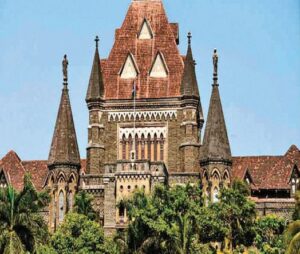 The Bombay High Court building
The Bombay High Court building
The Taj Mahal opened in 1903 and was first state-of-the-art hotel in Bombay, one of the most modern hotels in Asia with Moorish domes and with the finest European technology then available.
The fishing docks
As a coastal city, fishing is one of the most important activities in Mumbai. A trip to Mumbai is incomplete without a visit to Sassoon Docks, located at the southern tip of the city in Colaba. One of the oldest docks in Mumbai and the first wet dock constructed in the city, the zone appeals to tourists, photographers and fish-loving locals.
When built in 1875, Sassoon Docks was owned by the mercantile company David Sassoon & Co. Headed by Albert Abdullah David Sassoon who was the son of a Baghdadi Jew and the leader of the Jewish community in Bombay at the time, David Sassoon. Later in 1879, Sassoon Docks and other associated foreshore properties were purchased by the government on behalf of the Bombay Port Trust.
Every morning, the docks teem with activity with men offloading a variety of fish and sea creatures from their boats on to the docks and women selling fresh produce in the local market that also happens to be one of the largest fish markets in the city. Sassoon Docks is one of the few docks in the city that is open to members of the public.
The forts in Mumbai
It may come as a surprise but the city of Mumbai is also home to several forts that were built by the many rulers and colonists that ‘ruled’ Mumbai at several times in the last few centuries.
Bandra Fort, also known as Castella de Aguada – corruption of Castelo da Aguada which in Portuguese stands for ‘Fort of the Waterpoint’ – is one such fort located in Bandra, Mumbai. Built by the Portuguese in 1640, this fort was a watchtower overlooking Mahim Bay. When the Portuguese ceded the seven islands of Bombay in 1661, the fort became very important strategically.
Today, Bandra Fort is frequented by locals mostly and sometimes tourists who visit to relax in the premises overlooking the Bandra- Worli Sea Link. It is also a popular destination for couples who come to spend romantic moments with their partners. The fort is also popular among Bollywood filmmakers and has featured in many films. Other forts within Mumbai and in nearby areas include Worli Fort, Sewri Fort, Sion Fort, Vasai Fort, Kolaba Fort, etc.
Other popular tourist destinations
Mumbai is full of history stored inside the little-hidden pockets and the nooks of the city. With interesting stories waiting at every corner of the urban-metropolitan, one that amazes all is a quaint locality, hidden in the posh residential area of Malabar Hills. Dubbed as Mumbai’s own Varanasi, Banganga is a centuries-old ancient water reservoir, tucked away in Walkeshwar.
Despite being a stone throw away from the sea, the water flowing through the inlet is said to be fit for consumption. According to legend, when Ram, Laxman and Sita were on exile, Sita was thirsty, so Laxman shot an arrow on the ground and it resulted in water gushing through the ground.
Another popular tourist destination, the Haji Ali Dargah also known as Haji Ali is a mosque and dargah located on an islet in southern Mumbai. A monument of Pir Haji Ali Shah Bukhari, the structure is located off Worli coast and offers a picturesque view of the Arabian Sea especially during sunsets.
Mumbai is home to several structures and picturesque landscapes attracting both tourists and locals. Minara Masjid at Mohammed Ali Road lights up every evening rendering a special touch in the bustling zone. The mosque looks even more beautiful during Ramzan when the entire area transforms into a food court inviting food lovers from all over.
Hotel Majestic situated opposite Regal Cinema in Colaba was built by an Italian firm in 1909 and was, at one time, one of Mumbai’s premier luxury hotels. Later, it was converted into a hostel and canteen for members of the legislative assembly but retained its old world charm.
A heritage village located in Girgaum, Khotachiwadi is a small enclave with old- Portuguese style architecture. Founded in the 18 th century by Pathare Prabhu, the village came into being when Prabhu sold plots of land to local East Indian families. The enclave has a distinct characteristic and is often frequented by visitors with an interest in the diverse cultural and architectural heritage of the city.


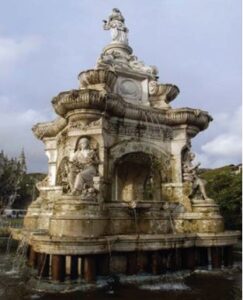 Flora Fountain
Flora Fountain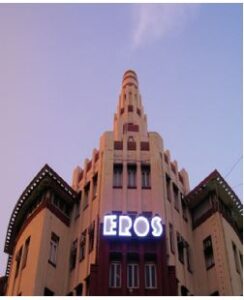 EROS Cinema theatre
EROS Cinema theatre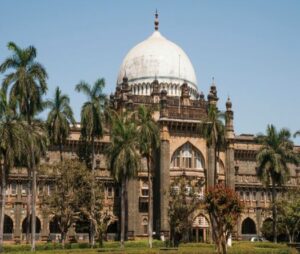 Chhatrapati Maharaj Vastu Sanghralaya ( earlier known as the Prince of Wales Museum), part of the Art deco ensemble
Chhatrapati Maharaj Vastu Sanghralaya ( earlier known as the Prince of Wales Museum), part of the Art deco ensemble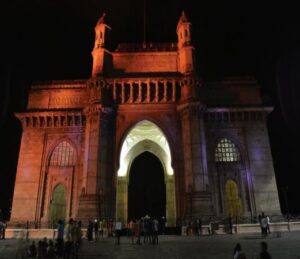 Gateway of India
Gateway of India BMC Building
BMC Building Sasoon Docks
Sasoon Docks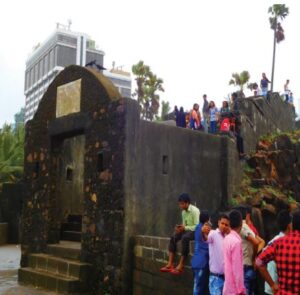 Bandra Fort
Bandra Fort 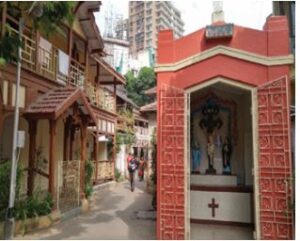 Khotachiwadi
Khotachiwadi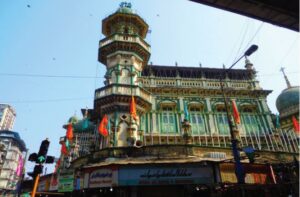 Minara Masjid
Minara Masjid